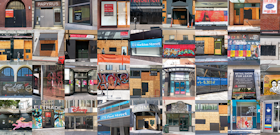|
A Long-Term San Francisco Retailer's View of What Happened to the 'City of
Lights'
This same story is playing out in a number of U.S. cities where homelessness
is just out of control
A VACANCY EPIDEMIC
They’re everywhere in Union Square and FiDi. What
can be done about it?
 In
more than 45 years in business, the proprietor of Cafe Madeleine, Bernard Hong,
never really thought about retirement. Now he does. In
more than 45 years in business, the proprietor of Cafe Madeleine, Bernard Hong,
never really thought about retirement. Now he does.
Now he arrives at his cafe at
5 each morning to clean
the sidewalk and rouse the homeless man
who sleeps out front before sending him off with a coffee.
He half suspects the
man’s presence is one reason why his cafe’s windows haven’t been broken.
Now he’s permanently closed the two cafes he operated for decades in the
Financial District and Union Square. These days he runs a skeleton crew to save
costs at his last remaining location on New Montgomery Street.
He counts off the nearby businesses he’s seen vacate the area amid the pandemic
or just before: Marshall’s, Walgreens, Barney’s, Forever 21, the yoga studio
that swooped in during a dip in rents and then out within a few months.
Pretty much anyone you ask will point out that the vibe is not good in Union
Square or the Financial District these days.
Fewer office workers,
shoppers and tourists have made homelessness and the prospect of theft or sudden
confrontation from mentally ill people a common threat.
It’s all combined to create a retail vacancy epidemic in Union Square and
downtown San Francisco. Though reliable numbers are difficult to come by, the
retail vacancy rate is arguably higher now than at anytime in the city’s
history. Shuttered and boarded-up stores dot the city’s most prominent streets.
The issue — both a symbolic one and economic one — is causing alarm among
business leaders, who are pressing the city to take more action to help solve
the problem.
“Art in the park is
great. Food trucks are great. Parades are wonderful — but not when people feel
unsafe.”
&uuid=(email))
Brokers have had to answer tough questions daily from prospective lessees about
the severity of retail theft and homelessness, featured prominently in
international exposés from the Wall Street Journal to the U.K.’s Independent.
And brokers must do their best to assure potential tenants that San Francisco
really does want them there, despite city policies they say range from
unsympathetic to hostile.
The city responded with
a
more rigorous effort on Sept. 22, with Mayor London Breed and Police Chief
Bill Scott announcing a new initiative to tackle retail theft.
The city will
reallocate three
sergeants to its organized retail crime unit, better coordinate the presence of
off-duty officers paid by retailers to provide security and make it easier to
report retail crimes over the phone. It’s also upping the number of retired,
unarmed cops on in certain neighborhoods as part of an ambassador program.
“We can do better than this,” Breed said at a news conference. “We can do a lot
better than this.”
Union Square stands out as the most hollowed out neighborhood, with a
record availability
rate of 21.6%.
"You really see it
first in New York, then we follow,
and it’s a much longer decline down, but when it rebounds, historically it’s a
much steeper curve.”
Although these retailers are subject to national trends that led to closures in
San Francisco and other major markets, brokers say the city gives these kind of
retailers very little reason to stay, noting
they are subjected to
security costs in the hundreds of thousands annually and the constant threat to
employees of harassment, violence and theft.
“Retailers, tourists and residents want to see evidence that the city has a
handle on crime and social problems we’re seeing play out every day,” Taylor
said. “Frankly I think our supervisors and mayor should be ashamed of
themselves. They’ve let one of the most beautiful cities in the world fall to
shambles.”
What the city has done
●
Announced plans to
reallocate officers to
fight organized retail crime,
coordinate off-duty, privately funded police presence at stores and add more
retired cops to the streets in an ambassador program.
●
Introduced a
vibrancy and safety plan for Mid-Market,
including the
expansion of community
ambassadors from Urban
Alchemy and more police patrols
●
Introduced the
Downtown Recovery Plan,
a $9.5 million investment to improve downtown foot traffic ahead of June’s
statewide reopening, that involves pop-up art and cultural events downtown,
improvements to Hallidie Plaza, and more street ambassadors in tourist areas
●
Unveiled
Shine on SF, $2
million initiative to
improve 311 response
times to graffiti and
garbage, interactive public art, social media campaigns
●
Announced plans to
provide grants of up to $2,000 for small businesses that have storefronts or
windows vandalized, initial $1 million funding pool
bizjournals.com
|